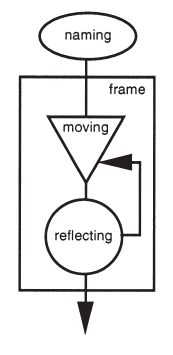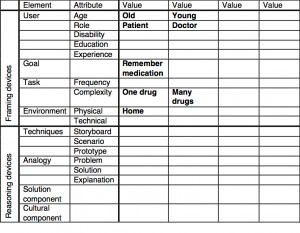We have developed a new coding scheme and visual notation that builds on Valkenburg and Dorst (1998) notation of the reflective cycle in designing (shown right). The notation uses an oval for Naming; a triangle for Moving; a circle for Reflecting. A Frame is captured as a bounding box. We later added a diamond for the use of Analogy.
Frames provides a focus for the discussion. Frames generate new design requirements or give a set of constraints.Names identify specific things you have to design or design for, such as functions and components. Moves explore the problem and solution space, expanding the brief and adding detail. Reflection is the evaluation of a design idea, concept or requirement. Is this a good thing to be doing? Why is it good? Analogy helps to transfer elements from the familiar (a source) to use it in constructing a novel idea (target).
Signature matrix
In order to code more consistently, our analysis was guided by the concept of frame signature matrix (Gamson and Lasch, 1983). A frame signature matrix unpicks a narrative by looking at ‘framing devices’ that suggest how to think about an issue; and at ‘reasoning devices’ that suggest what should be done about the issue. A frame signature matrix is constructed by interpreting the beliefs and meanings in terms of their professional practice and their culture. We have constructed a generic matrix (figure below) for our interaction design problem setting and repopulated framing and reasoning devices from the design brief. Participants identified several additional values (going beyond the values stated in the brief) for each frame.
Flow notation
In the signature matrix, the Naming of device values can be associated with a focus of the designers’ attention. The transition from each specific object to another is captured as the designers refine their thoughts or change their focus.
The diagrams below show the flow of design discussion between problem space (left hand side white) and solution space (right hand side grey space). The black line represents the designers shifting focus in discussion. There is movement along time (downwards) and movements across. We sometimes see bridging between problem and solution spaces. The vertical grey boxes show episodes in which problem and solution attributes are co-evolved. The overlaying coloured boxes signify the solution frames the designers create for the problem. The beginning of a new coloured box indicates reframing or returning to a previously discussed frame (if a colour is reiterated).
Although all sessions were approximately 1hour the length of the visual representation varies according to the amount of verbalisation and discursive turns taken.
Botswana flow diagrams Pairs 1-13
UK flow diagrams participant 1 and 3-7


















